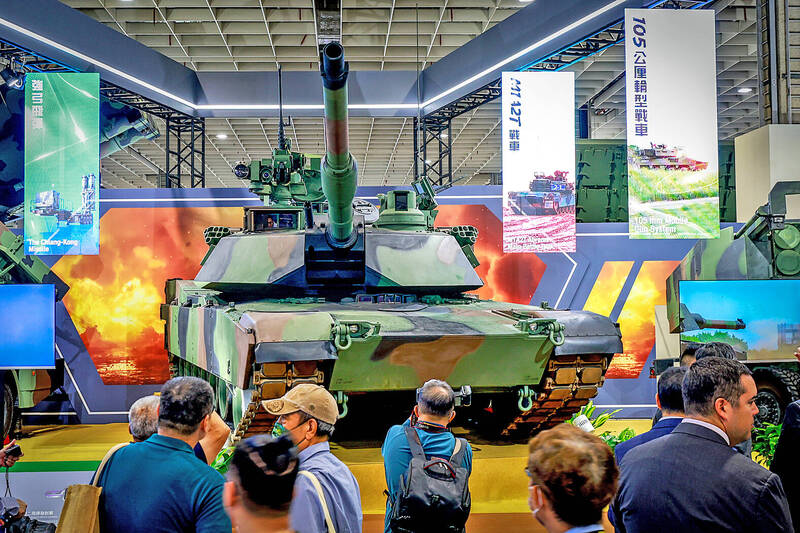Science
Taipei Air and Defense Exhibition Showcases Military Innovations

The Taipei Aerospace and Defense Exhibition commenced on March 26, 2024, marking a significant milestone in Taiwan’s defense landscape. The event features a record number of exhibitors and showcases 51 new military systems, underscoring Taiwan’s commitment to enhancing its defense capabilities amid evolving regional security challenges.
Taking place at the Taipei Nangang Exhibition Center’s Hall 1, the three-day exhibition runs through March 28, 2024, and hosts 490 exhibitors across 1,500 booths. This year’s participation has increased substantially from the previous year, which saw 275 exhibitors and approximately 960 booths.
During the opening ceremony, Karin Lang, Deputy Director of the American Institute in Taiwan, highlighted the expansion of the US pavilion, which has doubled in size to accommodate more than 40 American companies. “When American and Taiwan companies collaborate, they create solutions that enhance not just bilateral interests, but contribute to broader regional security and prosperity,” Lang stated. She addressed an audience that included Taiwan’s Minister of National Defense, Wellington Koo.
Taiwan’s defense strategy is increasingly focused on manufacturing independence. The Chungshan Institute of Science and Technology has announced a series of agreements with US and Canadian companies to co-produce key military technologies, such as anti-drone rockets from Canada’s AirShare and underwater surveillance drones from the US firm Anduril Industries. In a landmark development, Taiwan unveiled its first missile jointly developed with a US company, marking a pivotal moment in the growing defense collaboration between the two nations.
The institute’s president, Lee Shih-chiang, expressed the urgency of securing self-sufficiency in defense production. “Our goal is that if war or a blockade starts, we would be able to manufacture every weapon we need to protect ourselves,” he remarked. The exhibition prominently features the Barracuda-500, a low-cost, autonomous cruise missile that is the result of a joint effort with Anduril. The institute aims to establish a complete supply chain for the Barracuda-500 in Taiwan within 18 months, utilizing entirely Taiwanese components.
The exhibition showcases a diverse range of military innovations. The Ministry of National Defense’s pavilion is divided into four sections: joint operations weapons, uncrewed systems, dual-use technologies, and talent recruitment. Among the displays are advanced systems such as the M1A2T tank, the High Mobility Artillery Rocket System, and various missile systems, reflecting Taiwan’s multidomain deterrence strategy.
In light of lessons learned from the conflict in Ukraine, the uncrewed systems section presents 19 advanced technologies, including Mighty Hornet attack drones and autonomous vehicles. This focus on uncrewed systems underscores Taiwan’s commitment to enhancing its asymmetric warfare capabilities and expanding its domestic drone industry.
Additionally, the dual-use technology segment highlights innovative developments such as transparent electromagnetic pulse-shielding windows and next-generation security monitoring systems. These projects, developed through defense-industry-academic partnerships, aim to bolster Taiwan’s defense self-reliance while stimulating economic growth.
Previous exhibitions have attracted approximately 40,000 attendees, indicating strong public support for national defense initiatives. This year’s event includes interactive experiences and guided tours, aimed at engaging the public and enhancing their understanding of Taiwan’s defense capabilities.
Looking ahead, Taiwan has set a target of allocating 5 percent of its GDP to defense spending by 2030, an increase from 3.3 percent in the upcoming year. This anticipated rise in defense expenditure is projected to result in military hardware procurement totaling between US$50 billion and US$60 billion, as noted by Rupert Hammond-Chambers, president of the US-Taiwan Business Council. He indicated that approximately one-third of this investment would support domestic production, while the majority would involve international procurement, predominantly from the United States.
The Taipei Aerospace and Defense Exhibition underscores Taiwan’s strategic efforts to enhance its military capabilities and establish a robust defense industry that can respond effectively to regional security threats.
-

 Business5 months ago
Business5 months agoKenvue Dismisses CEO Thibaut Mongon as Strategic Review Advances
-

 Lifestyle4 months ago
Lifestyle4 months agoHumanism Camp Engages 250 Youths in Summer Fest 2025
-

 Sports4 months ago
Sports4 months agoDe Minaur Triumphs at Washington Open After Thrilling Comeback
-

 Sports5 months ago
Sports5 months agoTupou and Daugunu Join First Nations Squad for Lions Clash
-

 Top Stories5 months ago
Top Stories5 months agoColombian Senator Miguel Uribe Shows Signs of Recovery After Attack
-

 World5 months ago
World5 months agoASEAN Gears Up for Historic Joint Meeting of Foreign and Economic Ministers
-

 Health4 months ago
Health4 months agoNew Study Challenges Assumptions About Aging and Inflammation
-

 Business5 months ago
Business5 months agoOil Prices Surge Following New EU Sanctions on Russia
-

 Entertainment4 months ago
Entertainment4 months agoDetaşe-Sabah Violin Ensemble Captivates at Gabala Music Festival
-

 Entertainment4 months ago
Entertainment4 months agoBaku Metro Extends Hours for Justin Timberlake Concert
-

 Top Stories5 months ago
Top Stories5 months agoRethinking Singapore’s F&B Regulations Amid Business Closures
-

 Business5 months ago
Business5 months agoU.S. House Approves Stablecoin Bill, Sends to Trump for Signature









